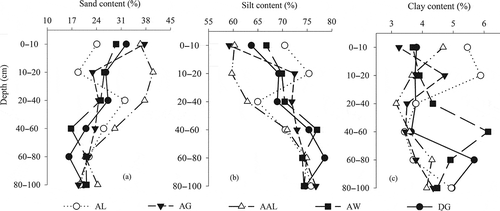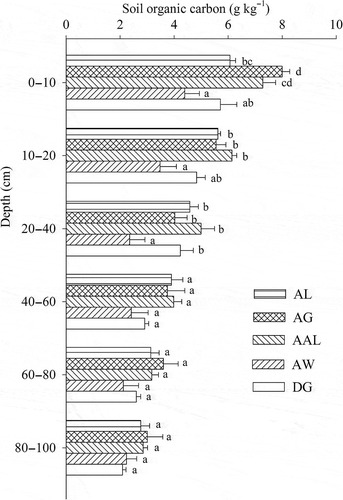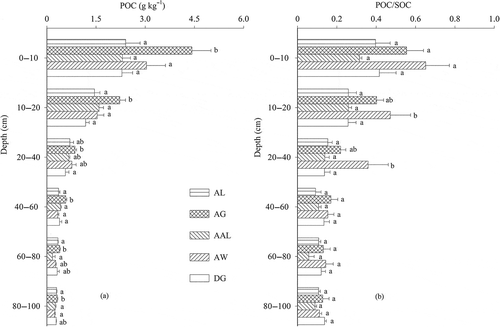Figures & data
Table 1 Description of different land use types
Table 2 Some soil properties as affected by land use change in the west of Loess Plateau.
Figure 2 Soil particle size distribution in the profiles among the different land-use changes of arable land (AL), artificial grassland (AG), abandoned arable land (AAL), artificial woodland (AW) and desert grassland (DG).

Figure 3 Soil organic carbon content in the profiles among the different land-use changes of arable land (AL), artificial grassland (AG), abandoned arable land (AAL), artificial woodland (AW) and desert grassland (DG). Different lower case letters indicate significant difference (p<0.05) among land uses.

Figure 4 Particulate organic carbon (POC) and POC:SOC ratio in the profiles among the different land-use changes of arable land (AL), artificial grassland (AG), abandoned arable land (AAL), artificial woodland (AW) and desert grassland (DG). Different lower case letters indicate significant difference (p<0.05) among land uses.

Figure 5 Labile organic carbon (LOC) and LOC:SOC ratio in the profiles among the different land-use changes of arable land (AL), artificial grassland (AG), abandoned arable land (AAL), artificial woodland (AW) and desert grassland (DG). Different lower case letters indicate significant difference (p<0.05) among land uses.

Figure 6 Biplot of PC1 (40.3% of the variation) and PC2 (25.0% of the variation) separating five land use types (AL, arable land; AG, artificial grassland; AAL, abandoned arable land; AW, artificial woodland; DG, desert grassland) using eight soil variables (0–10 cm depth). The variables that each principal component (PC) represents are given in .

Table 3 Variable loading coefficients (eigenvectors) for the first four principal components (PC) for nine soil variables (0–10 cm layer) from the principal component analysis (PCA) of the standardized values (correlation matrix), and their individual and cumulative percentage of total variance explained by each PC and eigenvalues

